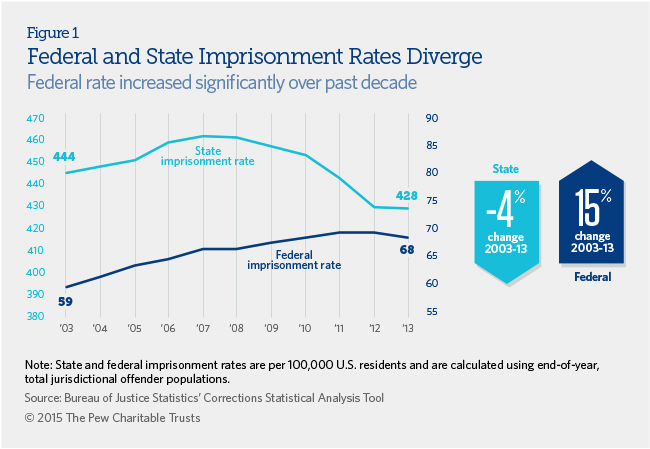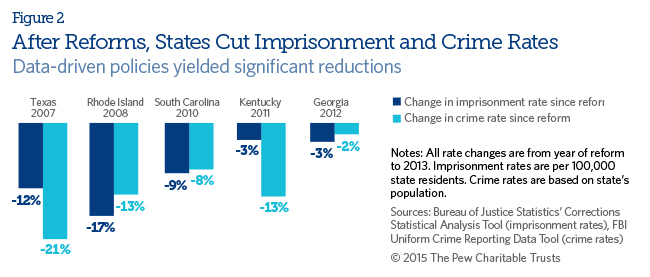Growth in Federal Prison System Exceeds States'
Federal imprisonment rate, taxpayer costs soar as states curtail expansion, protect public safety
Between 1980 and 2013, the federal imprisonment rate increased 518 percent, from 11 inmates for every 100,000 U.S. residents to 68.1 During the same period, annual spending on the federal prison system rose 595 percent, from $970 million to more than $6.7 billion in inflation-adjusted dollars.2 Prison expenditures grew from 14 percent of the Justice Department’s total outlays to 23 percent, increasingly competing for resources with law enforcement and national security programs.3
States, like the federal government, recorded sharp increases in incarceration and corrections costs over the past three decades. However, between 2007 and 2013, many states made research-driven policy changes to control prison growth, reduce recidivism, and contain costs. While the federal imprisonment rate continued to rise during that period, the state rate declined.

State Reforms
Since 2007, more than two dozen states have passed comprehensive, data-driven reforms designed to prioritize prison beds for serious offenders, reduce recidivism and incarceration rates, and avert new prison spending.4 An analysis of 17 states that have participated in the Justice Reinvestment Initiative—a collaboration that includes the U.S. Justice Department, The Pew Charitable Trusts, the Council of State Governments Justice Center, and other partners—found that they expect to prevent as much as $4.6 billion in corrections spending over the next several years.5 These states’ reforms may provide a guide for federal policymakers as they explore strategies to protect public safety, hold offenders accountable, and control corrections costs.

Endnotes
- All imprisonment data obtained using the Bureau of Justice Statistics’ Corrections Statistical Analysis Tool, accessible at http://www.bjs.gov/index.cfm?ty=nps. State and federal imprisonment rates are per 100,000 U.S. residents and are calculated using end-of-year, total jurisdictional offender populations.
- All spending data obtained from the Office of Management and Budget. For historical outlays by the federal prison system, see 2015 “Public Budget Database,” accessible at http://www.whitehouse.gov/omb/budget/Supplemental. For historical outlays by the Justice Department, see “Outlays by Agency, 1962–2019,” accessible at http://www.whitehouse.gov/omb/budget/Historicals. This report differs from other published accounts of federal prison spending by using actual Justice Department expenditures rather than congressional appropriations or budget authority figures.
- Office of the Inspector General, Department of Justice, “Top Management and Performance Challenges Facing the Department of Justice—2014” (Nov. 10, 2014), http://www.justice.gov/oig/challenges/2014.htm.
- The Pew Charitable Trusts, “Sentencing and Corrections Reforms in Justice Reinvestment States” (May 2014) http://www.pewtrusts.org/~/media/Assets/2014/01/01/Sentencing_v7.pdf.
- Urban Institute, “Justice Reinvestment Initiative: State Assessment Report,” http://www.urban.org/uploadedpdf/412994-JusticeReinvestment-Initiative-State-Assessment-Report.pdf.











